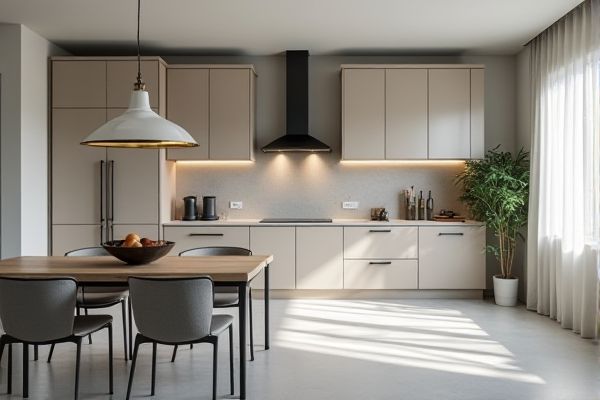
Metal cabinets offer superior durability, fire resistance, and load-bearing capacity compared to plastic cabinets, making them ideal for heavy-duty storage needs. Explore this article to understand how both options can fit Your storage requirements and decide which cabinet type best suits Your space.
Table of Comparison
| Feature | Metal Cabinets | Plastic Cabinets |
|---|---|---|
| Durability | High resistance to impact, scratches, and wear | Moderate resistance, prone to cracks under heavy load |
| Weight | Heavier, requiring sturdy support | Lightweight and easy to move |
| Corrosion Resistance | Susceptible to rust unless treated or coated | Highly resistant to moisture and corrosion |
| Maintenance | Requires periodic rust prevention and cleaning | Minimal maintenance with simple cleaning |
| Cost | Generally higher initial cost | More affordable upfront |
| Load Capacity | Supports heavy items efficiently | Suitable for light to moderate loads |
| Appearance | Industrial and professional look | Variety of colors and styles |
| Environmental Impact | Recyclable but energy-intensive production | Usually made from recyclable plastics |
| Ideal Use | Industrial, office, and heavy-duty storage | Home, garage, and lightweight storage |
Introduction to Metal vs Plastic Cabinets
Metal cabinets offer superior durability and resistance to impact, making them ideal for heavy-duty storage in industrial and office environments. Plastic cabinets provide lightweight, corrosion-resistant options that are easy to clean and suitable for damp or outdoor areas. Choosing between metal and plastic cabinets depends on factors like load capacity, environmental conditions, and maintenance requirements.
Material Composition and Durability
Metal cabinets are typically made from steel or aluminum, offering superior durability, resistance to impact, and enhanced protection against wear and tear compared to plastic cabinets. Plastic cabinets, constructed from polypropylene or polyethylene, provide lightweight and corrosion-resistant options but often lack the structural strength and longevity metal offers in heavy-use environments. Choosing between metal and plastic cabinets depends on your need for robust, long-lasting storage versus lightweight, moisture-resistant solutions.
Cost Comparison and Budget Considerations
Metal cabinets generally have a higher upfront cost compared to plastic cabinets due to their durability and strength, which can lead to long-term savings through reduced replacement frequency. Plastic cabinets offer a lower initial investment and are often preferred for budget-conscious projects or temporary storage solutions. When considering total cost of ownership, factors such as maintenance, lifespan, and environmental conditions should guide the choice between metal and plastic cabinetry.
Weight and Portability Differences
Metal cabinets are significantly heavier than plastic cabinets, which impacts their portability and ease of relocation. Plastic cabinets offer lightweight construction, making them ideal for frequent moves or flexible storage needs. Your choice depends on balancing durability with the convenience of transport.
Environmental Impact and Sustainability
Metal cabinets boast high recyclability rates, often made from steel or aluminum, which are infinitely recyclable materials that reduce landfill waste and energy consumption during production cycles. Plastic cabinets, typically derived from petrochemicals, have a longer degradation period and contribute to microplastic pollution, posing significant environmental challenges. Choosing metal cabinets supports circular economy principles and lowers carbon footprint compared to plastic alternatives, promoting sustainable material use and waste management.
Aesthetic Appeal and Finish Options
Metal cabinets offer a sleek, modern aesthetic with smooth powder-coated or brushed finishes that enhance durability and resist scratches, making them ideal for industrial or contemporary spaces. Plastic cabinets provide versatile finish options including textured surfaces and vibrant colors, allowing for customizable styles that suit casual or children's environments. Both materials cater to distinct design preferences, with metal emphasizing a refined, professional look and plastic prioritizing bright, lightweight, and flexible decorative applications.
Maintenance and Cleaning Requirements
Metal cabinets require regular cleaning with mild detergents to prevent rust and maintain their sleek appearance, often needing occasional touch-ups with anti-rust coatings. Plastic cabinets offer low-maintenance benefits, being resistant to moisture, stains, and corrosion, which allows easy wiping with standard household cleaners without risk of damage. Both types demand consistent cleaning to ensure longevity, but metal cabinets typically require more specialized care to avoid deterioration over time.
Safety and Security Features
Metal cabinets provide superior safety and security features, including fire resistance, durability, and robust locking mechanisms that protect valuable items from theft or damage. Plastic cabinets, while lightweight and resistant to corrosion, often lack the strength to withstand forced entry and offer limited fire protection compared to metal options. Your choice should consider the importance of safeguarding contents against physical threats and environmental hazards.
Best Applications for Metal Cabinets
Metal cabinets are ideal for industrial and heavy-duty storage due to their durability, resistance to impact, and ability to support heavy loads. They excel in environments requiring secure storage, such as workshops, garages, and manufacturing facilities, where protection against fire, moisture, and pests is crucial. You can rely on metal cabinets for organizing tools, machinery parts, and hazardous materials safely and efficiently.
Ideal Uses for Plastic Cabinets
Plastic cabinets are ideal for environments that require moisture resistance, such as bathrooms, laundry rooms, and outdoor spaces, where metal cabinets may corrode over time. Their lightweight construction makes them easy to move and assemble, perfect for temporary storage or frequently rearranged areas. Your choice of plastic cabinets ensures durability in humid conditions and offers a variety of colors and designs to match diverse interior styles.
 homyna.com
homyna.com